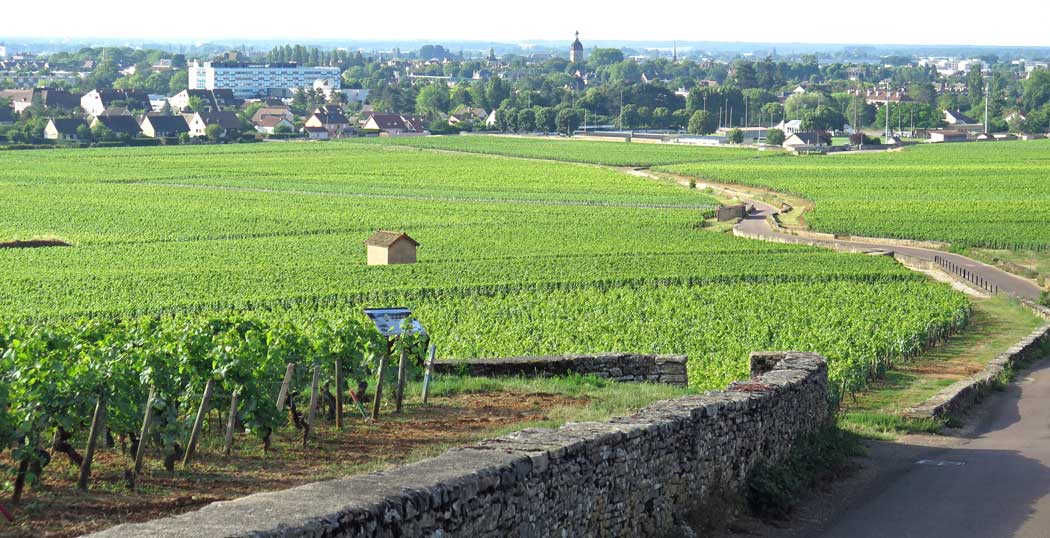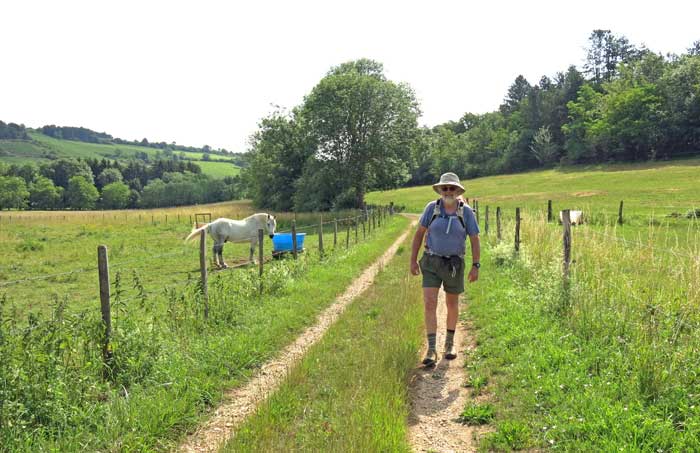
Saturday, 20 June 2015
Distance 21 km
Duration 5 hours 25 minutes
Ascent 502 m, descent 387 m
Map 136 of the TOP100 lime-green series
After our late arrival last night we did not wake up early, and it was 8 am by the time we left the camping ground. The office at the gate was just as closed as it had been when we arrived, so our few hours on the grass ended up costing us nothing.
On the other hand, we had been looking forward to boeuf bourgignon the night before at the classy camping restaurant, and we had missed out on that.
Some people were having breakfast in the sun at the restaurant as we walked out, but we decided to press on to Savigny-lès-Beaune, about an hour and a half’s walk, before stopping for refreshments.

A few hundred metres along, past a walled graveyard, we left the houses and entered the vines, where the true wealth of Burgundy was laid out before us.
On the east-facing slopes ahead, each parcel of land was delineated by low stone walls, with the vines clipped, topped and arranged in strict rows like well-combed green hair.
It was evidently the spraying season, as we saw several skinny tractors squeezing between the rows, with a toxic white mist rising from their antler-like system of pipes. Some drivers were in full protective suits and masks, others in shorts and T-shirts.


At the top of the rise we branched off on a stony path and started to descend. The vines gave way to open ground, then to a pine forest and we got a bit lost as we joined a dirt road, but realised our mistake and came back before we had lost too much height.
The correct way was marked with the red and yellow bars of a GRP and was a short, precipitous, rocky wheel track that ended at a bitumen road.
The wheel track was quite secluded and I took the chance to change from long trousers into shorts. Soon after that we went through an underpass and once again dived off, this time onto a tumbling path through a wood, and suddenly we were in the streets of Savigny-lès-Beaune.
Past the walled château grounds, with their great iron gates, we saw what we were looking for – a bar sign. It was called the X-treme Bar but the only thing extreme about it was that it was extremely closed.

However we pressed on, and after a lot of thrashing about we finally noticed another bar tucked away modestly in the side street near the Morgan restaurant (where we had dined delightfully in 2004).
There were no outside tables, as the street was so narrow, so we went inside and Keith went off to buy pastries (croissants that were particularly light and flaky, and a pain aux raisins that was particularly stodgy).

When he came back I was in conversation with a Dutch couple at the next table, who were interested in what we were up to.
Naturally they spoke excellent English and we had a pleasant chat. They were on their way to the Drôme and we advised them to keep away from Clairette de Die, the sickly sweet local drink of those parts.

Our route from there was along the river flats of the tiny Rhoin, where long vegetable patches were laid like a striped tablecloth beside the water, a sight to gladden any gardener’s heart.
After a kilometre the road curved around the camping ground and we took the second little road off, a wheel track through an ocean of grass.
A white horse watched us without enthusiasm as we walked by.

Then we came to a wooded hill and the track began to climb seriously. We could have taken another track, around the hill rather than over it, but it would have been much longer, and we were hoping for a view from the top.
We laboured up in a world of brilliant green, and finally reached the top, where we saw nothing except the nearby trees.
There was a flat section, beyond which the track plunged down and separated into several strands, which was confusing, but with the aid of our very detailed maps we picked the right one.
We climbed again, then descended awkwardly down to a tree-choked valley, the Valley of the Horses, where we passed through a tunnel under the autoroute. This gave us a strange feeling of disconnection, as our walk through the forest had felt so remote from civilisation.

The track continued through dense forest, then turned abruptly uphill and joined a small road, where were pleased to see GR marks, confirming our estimation of where we were.
However we only stayed on the GR for fifty metres before branching off the road onto an almost invisible path over a marshy field.

At the far end of the field it became a proper track which delivered us to a proper road (the D118a) just at the entrance to the hamlet of Bessey-en-Chaume.

This was no more than a few houses perching haphazardly on a slight rise among the meadows. The older houses seemed to be made of loose stones, without mortar, and we hoped they were stronger than they looked.
At the end of the village we veered off to the right and walked for about an hour on a thin tar road through fields and woods, past a line of wind turbines and some impressive piles of cut timber.
Eventually we came to a bigger road which descended rapidly and swept around a promontory above a river, then plunged into the village of Bligny-sur-Ouche.

We passed the church and continued down a long canyon-like street lined with charming houses, which opened out into a square in front of the Mairie. This was the centre of town, with a bar, a hotel-brasserie, several shops and the Office of Tourism.
Gleefully we cut across the square to the bar, but it was closed, so we went over the road to the brasserie. It was closed too, and there was a sign on the door saying that exceptional circumstances had caused them to close for the whole weekend.
It was almost 2 pm by this time and our glee turned to gloom as we contemplated the rest of the day without sustenance. The Office of Tourism was also closed, but would re-open later, so we decided to keep going to the camping ground and return later to ask their advice.

It was not far to the camping ground, which was down beside the station of the abandoned train line. Like the rest of Bligny, it was picturesque, with trees and thick lawns surrounding the ablutions block.
A sprinkling of tents and caravans occupied the outer perimeter but we put our tiny tent up in the middle, close to a picnic table, and sat there to eat a scrap of muesli with powdered milk, plus a banana that we had bought on the Canal du Midi.
We had two bananas but we only ate one, fearing that the other one would be dinner.

There was no office and no sign of anyone official. The showers were hot, strong and comforting, and after we had strung up our washing between two trees, we collapsed on our mats on the soft turf and did not move for a couple of hours.
At about 5 pm we wandered back to the square to visit the Office of Tourism, and found out that, although there was nowhere to dine tonight, there was a big supermarket near the camping ground.
Meanwhile the bar that had been closed when we arrived had re-opened and its terrace was occupied by beefy motor bike riders in leather jackets.
We sat down and had some of the worst coffee that we had ever drunk – cold, bitter and flavourless – but we enjoyed being among the flower beds and the people.

While we were thus engaged, a red pizza van drew up in front of the Mairie and the man began putting logs into his little kiln.
This looked like the answer to our prayers, but first we made a trip to the Maximart, which we had walked past twice already without noticing, as the entrance was in the side street. Here we bought a bottle of red Gaillac wine, three tiny lettuces, a huge ribbed Coeur de Boeuf tomato, and a tube of mayonnaise.
These were to accompany the pizzas. Then we got some flat peaches, half a baguette and a jar of rillettes, all of which were for our portable breakfast tomorrow.

Back in town, we ordered our pizzas from the truck and were told that they would take forty minutes, so we hung about in the square, and after a while we heard angelic music drifting from the Mairie. Peeping in at the door, we saw a red-shirted amateur orchestra practising. It was the final rehearsal of “Les Harmonies de Bligny et Arnay-le-Duc”, and the concert was later tonight.
However we had eating and sleeping to do, so we hurried off with our hot pizzas and re-occupied the picnic table near our tent. The camping ground was quite full now, but still there was nobody collecting money. In fact we never did manage to pay for our night at this lovely place.
We asked a Dutch couple to remove the cork from our bottle and set to work on dinner. Keith’s pizza was topped with anchovies and onions, while mine had mushrooms and ham.
They were both delicious but we found that we could not eat more than half, as our insides seemed to have shrunk.
Previous section: Capendu to Avignonet-Lauragais